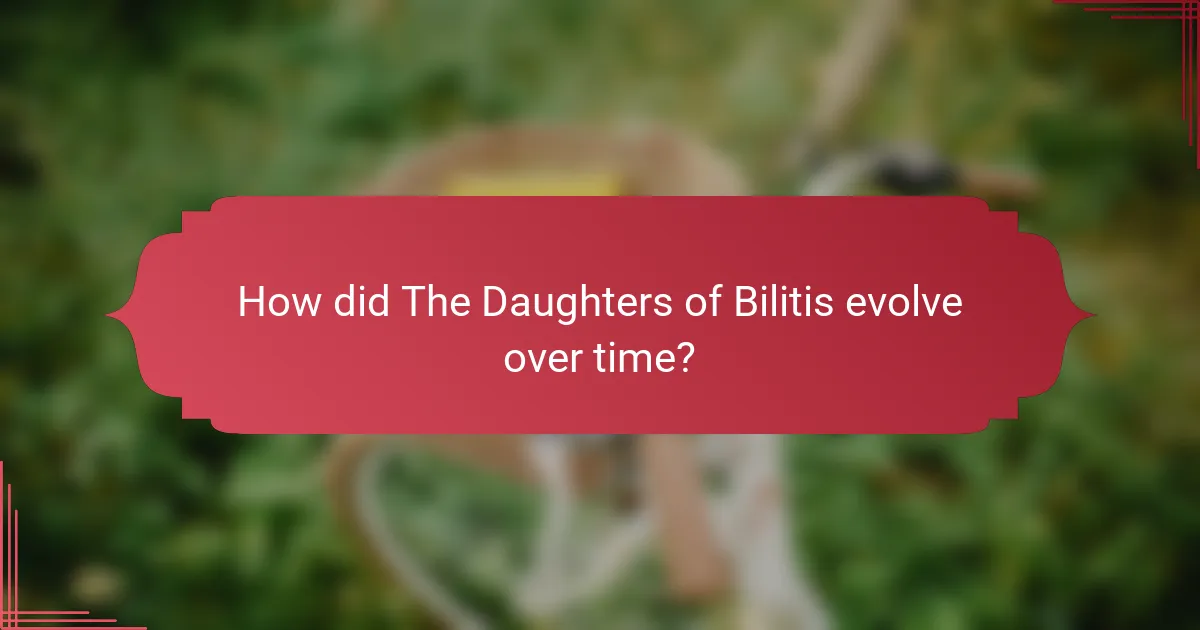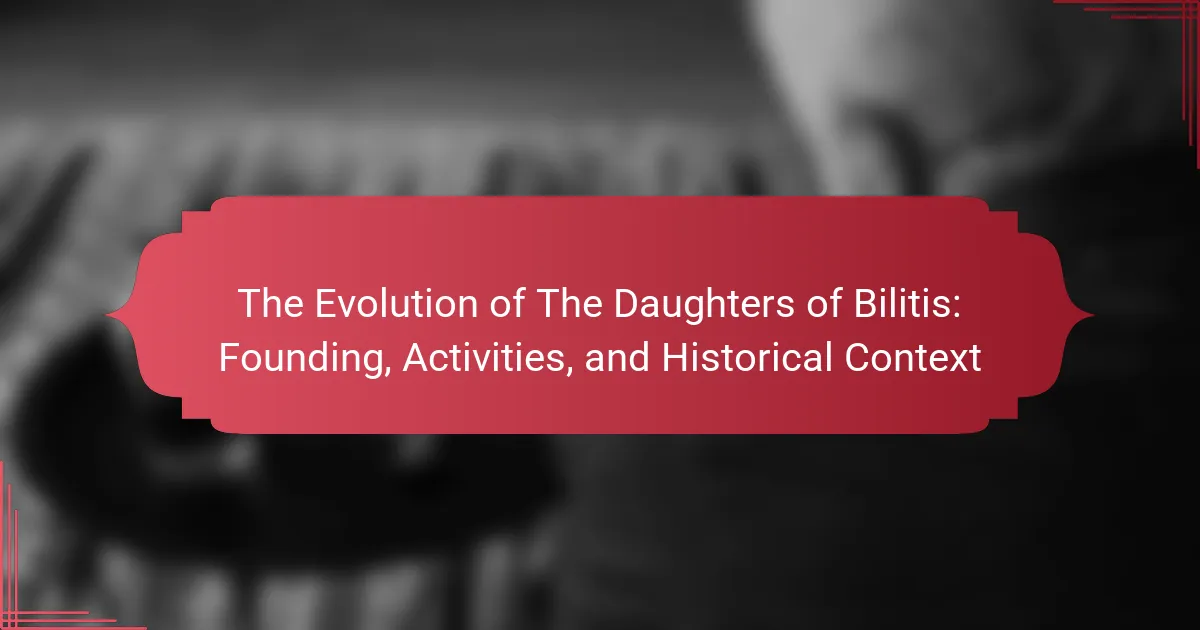
What is The Daughters of Bilitis?
The Daughters of Bilitis is recognized as the first lesbian civil and political rights organization in the United States. Founded in 1955 in San Francisco, it aimed to provide a social and political space for lesbians. The organization sought to combat discrimination and promote visibility for lesbian issues. It also published a magazine called “The Ladder,” which addressed topics relevant to the lesbian community. The Daughters of Bilitis played a crucial role in the early [censured] rights movement. Their efforts contributed significantly to the visibility and acceptance of lesbian identities in society.
How was The Daughters of Bilitis founded?
The Daughters of Bilitis was founded in 1955 in San Francisco. It was established by a group of lesbian women seeking community and support. The founders included Del Martin and Phyllis Lyon. They aimed to create a safe space for women to discuss their lives and experiences. The organization began as a social club, focusing on friendship and advocacy. It later evolved into a more politically active group. The Daughters of Bilitis played a crucial role in the early [censured] rights movement. Their efforts contributed to greater visibility and acceptance of lesbian women in society.
Who were the key figures involved in the founding of The Daughters of Bilitis?
The key figures involved in the founding of The Daughters of Bilitis were Del Martin and Phyllis Lyon. Del Martin and Phyllis Lyon co-founded the organization in 1955. They aimed to create a social and political support network for lesbians. Their efforts were pivotal in addressing the issues faced by the lesbian community. The Daughters of Bilitis was the first lesbian civil and political rights organization in the United States. Martin and Lyon’s leadership laid the groundwork for future [censured] activism. Their work helped to raise awareness and promote acceptance of lesbian identities.
What were the initial goals and objectives of The Daughters of Bilitis?
The initial goals and objectives of The Daughters of Bilitis were to provide support and community for lesbian women. They aimed to create a safe space for social interaction. The organization sought to educate the public about lesbian issues. They promoted understanding and acceptance of lesbian identities. The Daughters of Bilitis also advocated for civil rights and equality. Their efforts were focused on combating discrimination. They sought to empower lesbian women through visibility and representation. The organization played a crucial role in the early [censured] rights movement.
What activities did The Daughters of Bilitis engage in?
The Daughters of Bilitis engaged in social, educational, and political activities. They organized social gatherings to foster community among lesbian women. The organization provided a safe space for members to discuss issues affecting their lives. They published a magazine called “The Ladder,” which addressed topics relevant to the lesbian community. The Daughters of Bilitis also advocated for civil rights and worked to combat discrimination. They participated in the early [censured] rights movement, promoting visibility and acceptance. Their activities included lobbying for legal reforms and participating in demonstrations. The Daughters of Bilitis played a crucial role in raising awareness about lesbian issues during the 1950s and 1960s.
What types of events and meetings did The Daughters of Bilitis organize?
The Daughters of Bilitis organized social events, educational meetings, and advocacy gatherings. Social events included informal gatherings and parties to foster community among members. Educational meetings focused on topics like [censured] health, [censured] rights, and personal development. Advocacy gatherings aimed to address legal issues and promote social change. These events provided a platform for discussion and support within the [censured] community. The organization also held public events to raise awareness and visibility. Through these activities, the Daughters of Bilitis played a crucial role in the early [censured] rights movement.
How did The Daughters of Bilitis contribute to the [censured] rights movement?
The Daughters of Bilitis significantly contributed to the [censured] rights movement by being the first lesbian civil and political rights organization in the United States. Founded in 1955, they provided a platform for lesbians to organize and advocate for their rights. They published a magazine called “The Ladder,” which educated and informed the community about issues affecting lesbians. The organization also fought against discrimination and worked to improve public perception of homosexuality. Their efforts helped to create a sense of community and solidarity among lesbians during a time of widespread stigma. By engaging in activism and raising awareness, the Daughters of Bilitis laid the groundwork for future [censured] rights initiatives. Their legacy continues to influence [censured] advocacy today.
What historical context surrounded The Daughters of Bilitis?
The Daughters of Bilitis was founded in 1955 in San Francisco. It emerged during a time of significant social and legal discrimination against [censured] individuals. The 1950s in America were marked by widespread homophobia and anti-[censured] laws. The organization aimed to provide a safe space for lesbian women and advocate for their rights. It was the first lesbian civil and political rights organization in the United States. The Daughters of Bilitis sought to educate the public and promote acceptance of lesbian identities. Their activities included social gatherings, publications, and political activism. This context was crucial in shaping their mission and goals.
What social conditions influenced the formation of The Daughters of Bilitis?
The social conditions influencing the formation of The Daughters of Bilitis included widespread discrimination against homosexuals in mid-20th century America. During this time, homosexuality was criminalized and stigmatized. This environment led to a lack of support networks for lesbian women. The need for community and advocacy was crucial. The Daughters of Bilitis emerged as a response to these oppressive conditions. They sought to provide a safe space for lesbians. They also aimed to promote social acceptance and civil rights. Their formation marked a significant step in the fight for [censured] visibility and rights.
How did The Daughters of Bilitis interact with other [censured] organizations during its early years?
The Daughters of Bilitis interacted with other [censured] organizations through collaboration and mutual support. In its early years, the Daughters of Bilitis established connections with groups like the Mattachine Society. These interactions included joint events and sharing resources to promote [censured] rights. The Daughters of Bilitis also focused on education and advocacy, aligning their goals with those of other organizations. They participated in discussions about issues affecting the [censured] community, fostering a sense of solidarity. This collaboration helped to strengthen the visibility of [censured] issues during the 1950s and 1960s. Their efforts contributed to a more unified front in the fight for equality.

How did The Daughters of Bilitis evolve over time?
The Daughters of Bilitis evolved from a social organization into a significant political force. Founded in 1955 in San Francisco, it initially focused on providing a safe space for lesbian women. Over time, it began advocating for lesbian rights and visibility. The organization expanded its activities to include educational efforts on [censured] issues. In the late 1960s, it played a role in the broader [censured] rights movement. The Daughters of Bilitis published a magazine, “The Ladder,” which became a key platform for lesbian voices. By the 1970s, it faced challenges as the movement diversified. Ultimately, it helped lay the groundwork for future [censured] activism.
What significant changes occurred within The Daughters of Bilitis?
The Daughters of Bilitis experienced significant changes throughout their history. Initially founded in 1955, they aimed to provide a social and political network for lesbians. In the late 1960s, their focus shifted towards activism and advocacy for [censured] rights. This change aligned with the broader civil rights movements of the time. By the 1970s, the organization began to address issues of visibility and representation. They also expanded their outreach to include a wider range of [censured] individuals. The Daughters of Bilitis eventually disbanded in the early 1980s, transitioning into other [censured] organizations. Their legacy influenced future activism and the fight for lesbian rights.
How did the mission of The Daughters of Bilitis change in the 1970s and beyond?
The mission of The Daughters of Bilitis evolved significantly in the 1970s. Initially focused on social support and education for lesbian women, the organization began to embrace broader activism. By the 1970s, it shifted towards advocating for [censured] rights and visibility. This transition was influenced by the growing [censured] rights movement and increasing societal awareness. The Daughters of Bilitis started addressing issues like discrimination and legal rights. They also expanded their outreach to include all [censured] individuals. This change reflected a more inclusive approach to advocacy and community building. The organization’s activities became more aligned with national movements for equality and justice.
What challenges did The Daughters of Bilitis face during its evolution?
The Daughters of Bilitis faced significant challenges during its evolution. One major challenge was societal stigma against homosexuality in the mid-20th century. This stigma led to discrimination and fear of persecution among members. Legal restrictions on same-[censured] relationships further complicated their efforts for acceptance. Additionally, internal conflicts arose regarding the organization’s direction and priorities. The group struggled to maintain unity amid differing views on activism and social change. Limited funding and resources also hampered their initiatives. These obstacles shaped the organization’s development and strategies over time.
What impact did The Daughters of Bilitis have on society?
The Daughters of Bilitis significantly impacted society by advocating for lesbian rights and visibility. Founded in 1955, they became the first lesbian civil and political rights organization in the United States. Their efforts helped to challenge societal norms and stigmas surrounding homosexuality. They provided a safe space for women to connect and share experiences. The organization published a magazine, “The Ladder,” which educated and informed the public about lesbian issues. Their activism laid the groundwork for future [censured] movements. The Daughters of Bilitis also influenced the broader fight for women’s rights. Their legacy continues to inspire advocacy for [censured] equality today.
In what ways did The Daughters of Bilitis influence public perception of [censured] individuals?
The Daughters of Bilitis influenced public perception of [censured] individuals by advocating for lesbian rights and visibility. They published “The Ladder,” the first lesbian magazine in the U.S., which educated readers on [censured] issues. The organization held social events that fostered community and acceptance among lesbians. They also engaged in activism, challenging discriminatory laws and societal norms. Their presence in the 1950s and 1960s helped normalize lesbian identities. By promoting dialogue, they contributed to a broader understanding of [censured] individuals. Their efforts laid groundwork for future [censured] movements.
What legacy did The Daughters of Bilitis leave for future generations?
The Daughters of Bilitis left a significant legacy of advocacy for [censured] rights and visibility. They were the first lesbian civil and political rights organization in the United States. Founded in 1955, they challenged societal norms and provided a support network for lesbians. Their work contributed to the visibility of lesbian issues in a time of widespread discrimination. They published “The Ladder,” the first national lesbian magazine, which educated and connected the community. Their activism laid the groundwork for future [censured] organizations and movements. The Daughters of Bilitis also helped in the fight against oppressive laws and social stigma. Their legacy continues to inspire current and future generations in the ongoing struggle for equality.

What lessons can we learn from The Daughters of Bilitis today?
The Daughters of Bilitis teach us the importance of community and advocacy for marginalized groups. Founded in 1955, they were the first lesbian civil and political rights organization in the United States. Their efforts highlighted the need for visibility and acceptance of [censured] individuals. They organized social events and published a magazine to educate the public. This approach fostered a sense of belonging among lesbians at a time of widespread discrimination. Their legacy shows the power of grassroots activism in effecting social change. Today, these lessons remain relevant as communities continue to fight for equality and representation.
How can the history of The Daughters of Bilitis inform current [censured] activism?
The history of The Daughters of Bilitis provides foundational insights for current [censured] activism. Established in 1955, the organization was the first lesbian civil and political rights group in the United States. Its creation marked a significant shift in the visibility and activism of lesbian women. The Daughters of Bilitis focused on education and community building, which are essential strategies for advocacy today. They published a magazine, “The Ladder,” which facilitated discourse on lesbian identity and rights. This emphasis on communication remains vital in contemporary activism. The group’s efforts to combat discrimination laid groundwork for future movements. Their legacy highlights the importance of solidarity and organized action in achieving rights. Understanding their history can inspire current activists to pursue inclusive and informed strategies.
What strategies used by The Daughters of Bilitis can be applied to modern movements?
The Daughters of Bilitis utilized strategies that can be applied to modern movements, such as community building and education. They fostered a sense of belonging through social gatherings and support networks. This created a safe space for individuals to share experiences and challenges.
Additionally, they focused on raising awareness and educating the public about [censured] issues. They published a newsletter, “The Ladder,” to disseminate information and promote dialogue. This approach can enhance visibility and understanding in contemporary movements.
Moreover, advocacy for legal rights was a key strategy. The Daughters of Bilitis campaigned for the decriminalization of homosexuality. Modern movements can similarly push for policy changes and legal protections.
Their emphasis on intersectionality is also relevant today. They recognized the diverse experiences within the [censured] community. This understanding can help current movements to be more inclusive and representative.
Overall, the strategies of community engagement, education, advocacy, and intersectionality are applicable to modern movements.
Why is it important to remember the contributions of The Daughters of Bilitis?
The contributions of The Daughters of Bilitis are important because they played a pivotal role in the early [censured] rights movement. Founded in 1955, they were the first lesbian civil and political rights organization in the United States. Their advocacy helped challenge societal norms and promote visibility for lesbian issues. They provided a support network for women, fostering community and empowerment. The organization also published “The Ladder,” the first nationally distributed lesbian publication. This platform educated and informed readers about [censured] rights and issues. Remembering their contributions highlights the historical struggles and achievements in the fight for equality. Their legacy continues to inspire contemporary movements for [censured] rights and acceptance.
What resources are available for learning more about The Daughters of Bilitis?
Books, articles, and documentaries provide resources for learning about The Daughters of Bilitis. Notable books include “The Daughters of Bilitis: A History” by Susan Stryker. Academic articles can be found in journals focused on [censured] studies. Documentaries such as “Before Stonewall” feature the organization’s impact. Online archives, like the GLBT Historical Society, offer primary sources. Websites dedicated to [censured] history also provide valuable information. These resources cover the group’s founding, activities, and historical context.
Where can one find historical documents and literature related to The Daughters of Bilitis?
Historical documents and literature related to The Daughters of Bilitis can be found in various archives and libraries. The ONE National [censured] & Lesbian Archives holds a significant collection of materials. The San Francisco Public Library also houses relevant documents. Additionally, university libraries, such as the University of California, Berkeley, may have specialized collections. Online databases like JSTOR and Project MUSE provide access to scholarly articles. These resources contain primary and secondary sources on the organization’s history and impact.
What organizations continue the work initiated by The Daughters of Bilitis?
The work initiated by The Daughters of Bilitis is continued by several organizations. Notable among them are the Lesbian Rights Project and the Human Rights Campaign. These organizations advocate for [censured] rights and provide support to the community. They focus on legal advocacy and social awareness. The Lesbian Rights Project specifically addresses issues faced by lesbian individuals. The Human Rights Campaign works on broader [censured] rights, including legislative efforts. These organizations build upon the foundation laid by The Daughters of Bilitis in the 1950s. Their ongoing efforts reflect the original mission of promoting equality and acceptance.
The Daughters of Bilitis is the first lesbian civil and political rights organization in the United States, founded in 1955 in San Francisco by Del Martin and Phyllis Lyon. The organization aimed to provide a supportive community for lesbians, combat discrimination, and promote visibility of lesbian issues through activities such as social gatherings and the publication of “The Ladder.” The article explores the founding, goals, activities, and historical context of The Daughters of Bilitis, highlighting their significant contributions to the early [censured] rights movement and their lasting impact on societal perceptions of lesbian identities. Additionally, it discusses the organization’s evolution over time, challenges faced, and the legacy they left for future [censured] activism.
